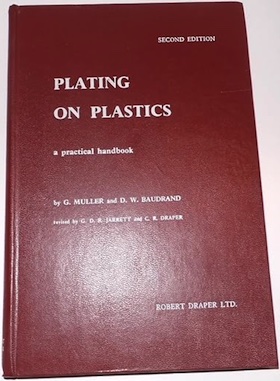
Curated with aloha by
Ted Mooney, P.E. RET

The authoritative public forum
for Metal Finishing 1989-2025

-----
Racks for plating ABS/plastic get electroless nickel plated
finishing.com is possible thanks to our supporting advertisers, including:

Q. hello
OUR COMPANY(ARJAN) DOES PLASTIC PLATING. I HAVE A PROBLEM ABOUT PLATING ON PLASTISOL FIXTURES AND PREVENTING THIS PROBLEM. I DO PLASTIC PLATING IN TWO STEPS:
• STEP ONE IS PICKING UP THE PARTS ON STAINLESS STEEL FIXTURES
• AFTER ELECTROLESS NICKEL REMOVING THE PARTS FROM THESE RACKS AND PUTTING THE PARTS ON PLASTISOL FIXTURES.
PLEASE HELP US DO IT IN ONE STEP WITH PLASTISOL FIXTURES.
- IRAN /TEHRANVARAMIN & IRAN /TEHRAN
December 11, 2021
A. Hi Asghar. We added your question to a long-running thread about the issue. In summary the readers seem to be saying that only high quality plastisol coating, and only in very good condition (unscratched, not exposed to nitric acid stripping too many times, and not more than two years old) will work. And further, that the electroless nickel process must be fairly modern and designed for no re-racking.
Make certain that you have carts or horizontal bars on your walls where racks can hang when not in use. Setting plating racks on the floor is a sure way to quickly ruin them.
Luck & Regards,

Ted Mooney, P.E. RET
Striving to live Aloha
finishing.com - Pine Beach, New Jersey
December 2021
RFQ: Hi.
In plastic plating we have deposition on fixture.
What is the condition temperature and concentration that we have no deposition of metal on fixture.
If you know a company that sells plastisol say to me for buying.
Thanks a lot
- tehran iran
January 20, 2022
privately respond to this RFQ
Ed. note: As always, gentle readers: technical replies in public and commercial replies in private please (huh? why?)
⇩ Related postings, oldest first ⇩
by American Society for Electroplated Plastics

on AbeBooks
or eBay or
Amazon
(affil links)
Q. Dear sir;
We are plastic plating in Turkey. We have a problem. When we are plating electroless nickel, our rack is plating. We don't want plating on our rack because we want to do acid copper plating on the same rack. How can we solve this problem?
best regards
- IZMIR, TURKEY
2005
A. Hi,
Aren't the racks isolated?
Regards,
- Mexico City, Mexico
2005
Q. Yes, they are isolated with plastisol, but the plastisol is getting plated (electroless nickel plated).
MURAT CETIN [returning]- IZMIR, TURKEY
2005
A. Merhaba Murat,
I think the main problem that you have is actually with your isolated racks ;-)
Handling with Plastisol as an rack isolator expects a very accurate work. The temperature is in this case very important to avoid any pores in the surface. I do not know how old your racks/insulation is, but during the process the surface gets more and more porous and it will plate out with nickel (chemical-wise). To avoid this problem you should renew the insulation after a certain turn around in the process; also contact the supplier/manufacturer of the insulation and tell him your problems, he might/should change his procedure.
Regards,
- Mexico City, Mexico
2005
A. I have some experience with three different EN baths, all the same sort (7-10% Phosphorus). One of them (older type from local supplier) causes plating even on Teflon heater and PP tank, while modern bath from Germany (with higher plating rate giving very bright coatings) nearly doesn't have this problem. Plating on heater and tank walls is much more extensive when there is damage (scratches) on them, or when there are (even invisible) remains of Ni coatings on them.
Frantisek Haas- Jablonec, Czech Republic, Europe
2005
A. Well, the most damage and the cause of Ni-plating of equipment mostly happens because of too long or too frequent cleaning/stripping with nitric acid.
Regards,
- Mexico City, Mexico
2005
A. Hi Murat,
When one plates plastics, one needs to prep the material in some manner ... so this got me thinking that perhaps, as Dominik clued me in, you could consider just brush coating the ABS rack with some ABS cement (MEK solvent may not work) to, pardon the poor English, virginilize the rack so that, for a period of time it will not get plated and it will fill in, one hopes, those scratches that lead to plating.
Try it... inexpensive, too.
Just an idea.

Freeman Newton [deceased]
(It is our sad duty to advise that Freeman passed away
April 21, 2012. R.I.P. old friend).
2005
A. Dear Mr.Murat,
We also have plastic plating line. We have different jigs in pre line; after electroless we are unloading the jobs and reloading on plating jigs, so there is no contamination.
Pre-line jigs you need to repair frequently because over time plastisol gets cracked so that electroless nickel starts depositing on it.

Vishwas Nangare
motorcycle accessories mfgr.
- Aurangabad, Maharashtra, India
2005
A. Modern processes for plating on ABS do not need re-racking before EN. All modern process are called "no re-rack". It depends on the chemicals that you use between the Palladium containing solution and the EN.
Contact your supplier and ask him about "no re-rack" process for ABS.

Sara Michaeli
Tel-Aviv-Yafo, Israel
2005
Material of Construction for Perfect Electroless Nickel Plating Racks?
June 17, 2008Q. Circuit boards will abrade any coating. Therefore I want to construct a rack that is intrinsically non-plating in electroless nickel. Furthermore, it must not plate in immersion gold further down the line as the electroless nickel will plate on top of the gold on subsequent cycles.
I'm thinking of a cadmium or lead containing alloy to shut down the EN reaction. Why hasn't this been tried?
Less preferable, would be a coating of Cadmium-gold if there even is such a thing?
Things I have considered:
1. Titanium readily plates up with immersion gold. I expect the gold to plate over with EN on subsequent cycles so I don't think this is a promising approach.
2. The pre-clean line contains acids that will corrode nickel-containing steels and especially copper.
3. A rack constructed from 1/2" PVC square rod is too brittle.
4. Halar or KF coating does not stand up to the abrasion.
Engineer - Rochester, New York, U.S.A.
A. The answer to the first question is easy as both of those metals will dissolve slightly in the EN and both are extreme brighteners at trace levels, so their use will poison your EN tank and will affect the properties of the EN before you cannot use it any longer.
Look into Ultra high molecular weight PE (UHMW PE). It is great stuff, but I do not know if it will take the high temp of the EN. It is extremely abrasion resistant, but cannot be welded by normal hot air means.
What have the professional rack making companies said about your problem?
- Navarre, Florida
June 20, 2008
Q. The "professional rack making companies" are quite happy to re-coat the racks every 3 months thank you very much. Furthermore, if they had the ingenuity to solve this challenge they wouldn't be making racks!
I should add that the preferred style of rack is to have a series of opposing channels approximately 0.200" wide to slip the circuit boards into. UMHWPE channels are simply not available unless machined which is expensive. Even if they were, I don't see how you would join them to the rack structure without screws.
printed circuits - Rochester, New York, U.S.A.
June 21, 2008
A. Hi, Peter. A milling machine can cut a groove like that very quickly; I don't think it would be expensive at all. The screws can be countersunk to stay out of the way and can also be made of UHMWPE although these would probably be fairly costly, but less expensive plastic screws are available. Or the screws could thread into tapped holes in the UHMWPE from the other side (the heads of the screws on the other side of the frame and plastisol coated or countersunk then covered with a plug).
Regards,

Ted Mooney, P.E.
Striving to live Aloha
finishing.com - Pine Beach, New Jersey
June 23, 2008
![]() UNMWPE would work for the channels, although I see nothing wrong with CPVC which is easier to work with. The big challenge is the rack frame.
UNMWPE would work for the channels, although I see nothing wrong with CPVC which is easier to work with. The big challenge is the rack frame.
I am trying to get away from plastisol, or any, coatings. Aluminum (especially 6063) works well in all the baths in the line except for the cleaner tank which contains HCl. I would expect the tenacious oxide layer of Zirconium to protect in the same way and hold up to the cleaner too, although Zr sells for about $100/pound!
- Rochester, New York, U.S.A.
June 25, 2008
Multiple threads merged: please forgive chronology errors and repetition 🙂
Nickel is plating onto PVC plastisol coated plating racks
Q. Dear sir, we are facing the problem of depositing nickel on PVC coated jigs in ABS plating plant. Kindly let us know the reason (is this is problem of plastisol or something else) and solution.
Jyoti Kambojmanufacturer - Delhi, India
May 31, 2009
A. I would say either the coating is thin enough to allow a little attraction, and allowing the rack to become "encapsulated" with plate, or there are pinholes in the plastisol. A spark tester will demonstrate if there are voids in the coating, and their location. There is also the remote possibility that the plastic was somehow made "plateable", but this seems pretty far-fetched...
George Brackett III- Maine
June 18, 2009
A. We found that we would get 1-2 years of use out of a rack before it started to plate. Normally it happened in an area that had been roughed up or abraded-IE: the smooth surface was not smooth any more.
We would strip and re plastisol the rack in house. Some times we would use a couple of layers of 1" platers tape to get a bit longer life out of it. Now, there are vinyl patch kits available or you can try the vinyl for pliers handles that can be bought in some auto parts stores and some big box stores. It will extend the useful life of the rack until you can find time or money to just recoat the rack.
- Navarre, Florida
June 20, 2009
A. We had trouble with a polypro tumbler barrel plating in EN. The problem turned out to be poor rinsing of our parts. The part were ground prior to plating. Fines trapped in a lip on the parts "seeded" the plating barrel, and we got patches of nickel on the more porous parts of the barrel where the metal fines got trapped.
Michael Costello- Grand Junction, Colorado, USA
June 23, 2009
A. Jyoti, You give us your problem but do not tell us how you got there! It seems to me like the Plastisol jig is becoming suitable for electrodeposition, but the reasons for it are unclear. It could be that the Plastisol has started to break down and is not offering the insulation to the jig that it should, or it could be that you are using the jig in the ABS activation process and as a consequence you have also activated the jig.
The remedies are slightly different for either cause. The initial thing is that you need to strip down your jigs and recoat them. This will solve the problem in the short term. If you are using the jigs to activate the ABS, stop doing so! This will entail you buying or making more jigs specifically for the activation process. You will then need to find a way of transferring the activated ABS parts to other jigs that will not take up metallisation; this could be a tricky step, but since we don't know what you are doing, we cannot offer any guidance from here in.

Trevor Crichton
R&D practical scientist
Chesham, Bucks, UK
July 3, 2009
Old & new plating racks suffer plate-out in Direct Plating Process
Q. Hi, We are doing plating on ABS plastic through the so called "direct plating" process. Recently, both new jig racks and old jig racks are also plated. We are sure that is abnormal. We suspect the main cause is the Palladium Chloride Activation chemical problem. Anybody can explain it? Any suggestions?
Yinsong Huang- Singapore
September 11, 2013
![]() Hi Yinsong. I guess I'm lost due to my dated knowledge, but I thought the whole idea behind direct plating was to use graphite or similar processes to eliminate the need for palladium chloride and electroless plating.
Hi Yinsong. I guess I'm lost due to my dated knowledge, but I thought the whole idea behind direct plating was to use graphite or similar processes to eliminate the need for palladium chloride and electroless plating.
Regards,

Ted Mooney, P.E.
Striving to live Aloha
finishing.com - Pine Beach, New Jersey
July 2014
Q. Hi sir,
I would like to discuss some issues which I have faced in electroless plating. Especially when I run steel parts for plating, I find that the steel hook is also getting plating and we always need to strip out before the next cycle. It's making us lose time as well as production. Can you please suggest something to overcome this issue? Also what will be the best material we can use for jig hooks?
Regards,

JUSTIN JOSE
- semenyih, selengor, malaysia
October 17, 2014
A. Hello Justin,
Your best bet is to have the jigs coated with plastisol. The coating should be rated for high temps as employed in E-Less Ni. If you google "rack mfgrs" in your area, they would be able to coat them for you. I would ask that the plastisol coating is to be as thick as possible, where the hooks will still accommodate your work. When I was plating E-Less Nickel and Immersion Gold, I had the racks re-coated at the highest possible plastisol coating thickness, because it would wear off over time and the stainless rack would be exposed and get plated. Luckily, we were only depositing 3-5 microinches of Gold so the loss was minimal. Good Luck.
Process Engineer - Phoenix, Arizona USA
November 8, 2014
Q, A, or Comment on THIS thread -or- Start a NEW Thread

